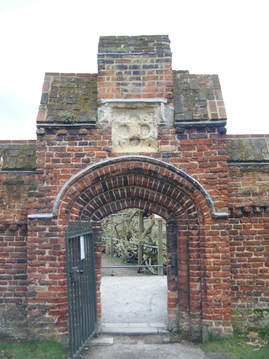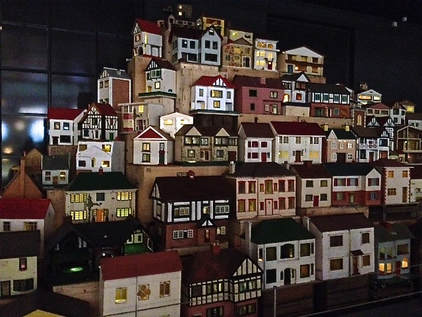The importance of thresholds and seams
and in between them, there are doors.'
William Blake
The V&A's threshold space
The opening of the V&A's new Exhibition Road entrance in June 2017 changed the relationship between the museum and the spaces and places on Exhibition Road, including the National History Museum and the Science Museum. The design, by Amanda Levete Architects, also links in (almost) seamlessly with the Shared Space design of the road; a Dutch innovation, Shared Space is a counterintuitive approach to road safety that involves removing the usual barriers, signs and traffic lights that separate pedestrians from cars. Recently, V&A Director Tristram Hunt suggested that the new entrance had helped the museum attract a 26% increase in visitors and that one factor is that the new entrance is less intimidating than the grand 'castle keep' way in on Cromwell Road. “All the data we have shows that it is much more attractive to non-traditional museumgoers,” said Hunt. “It is less, frankly, scary.” (The Guardian, 18 July 2018).
The new entrance also created a 'transition zone' as recognition that entering the museum (any museum) can be intimidating for some visitors. On the V&A's blog, Kati Price explains:
'The new Sackler Courtyard offers a ‘decompression zone’ – a threshold space between the busy Exhibition Road and the Museum itself. Like plazas, parks and entrance courtyards to other museums, this threshold space allows people to enjoy the beautiful surroundings without having to commit to entering the building. These are important transitionary spaces, helping to ease people into the Museum which – for some – can be intimidating.'
My experience as a Welcoming Ambassador at the V&A is that people using the new courtyard are often confused as to whether or not they are in the museum – indeed some aren't even aware it is a museum. It intrigues while at the same time giving the impression of being open to all – even if they don't always know what 'it' is.
Yet the effect achieved may not be what was intended, and partly that's down to the unpredictability of people. Price describes the ambitions for a 'digital welcome' to the museum, using apps and other digital technologies to help visitors explore the museum and its collections and heritage. But she notes that so much changed from 2012, when that ambition was originally set out, in terms of technology but also in the understanding of people's behaviour. What she and colleagues discovered is that instead of focusing on the 'digital welcome', they needed to take a step back and consider what people wanted, realising that 'to separate out the digital from other elements of the welcome experience risks a fragmented visitor experience that doesn’t intuitively blend the digital and the physical'. They attempted to map the 'visitor experience' – the physical, as in spaces in the museum, and the emotional, the visitor's responses to what she saw. This gave them fresh insights into the way the museum was using digital technology and 'touchpoints', not always to best effect. And it emphasised that real people – the staff and volunteers 'on the shop floor' – were a necessary ingredient.
This stepping back also taught the V&A that digital offerings (apps, maps and information) are ever only part of the story – people still want stuff on paper, and they want the right information at the right time. Price summarises the key learning points as:
- Recognise our people as a vital part of the experience
- Make our touchpoints more visible
- Define a clear purpose for each touchpoint
- Make a more consistent experience
- Provide the right information at the right time
These may seem like obvious, 'Mom and apple pie' type revelations – who wouldn't argue for more consistency and recognising people as vital ingredients? – but they are in fact a reflection of how far the vision shifted from the original 'digital by default' vision set out in the V&A's Heritage Lottery Fund application. (I'm struck by the parallels with the justice system. I'm currently working with a colleague on a book project on administrative justice and human rights, and how the two can be re-imagined with the help of the world of design. There is much in what the V&A learned that is relevant for digitalisation of the justice system, which, like any major museum with historic but confusing architecture, can be daunting to first-time visitors. But one key difference is that the V&A's strategy is to get more people into the museum. The HMCTS's strategy may well be to keep people out of its system, to make the workload more manageable and to keep costs down. That at least is a widely shared sceptical view of the intentions of the current justice reform programme.)
People and their places – connectivity and threshold
Mae Architects explore how 'unexpected engagement' is designed into a space by allowing free movement between spaces and 'loose fitting', even advocating for some degree of non-design: 'Architecture which has enough presence to step back and not do the jazz-hands thing in public can be absorbed as part of a city.' Too much coherence locks you in; 'urbanistically being too specific can create monocultures'. Manzini sees connectivity as creating flexibility; it loosens and makes more fluid, in the way that temperature can affect the fluidity of materials.
Seams
This plasticity and flexibility and the encounters it can promulgate reflects too the intention of Shared Spaces, as in Exhibition Road just outside the V&A's new entrance. What Hans Monderman (the Dutch engineer who invented the concept of Shared Space) observed was that these safety elements of kerbs, crossings, traffic lights and railings prevent road users from interacting with each other; when lines are blurred between street and pavement, users are forced to look, engage and negotiate with one another, eye to eye. Monderman created more than 100 shared spaces in the Netherlands, and studies he carried out showed a reduction in accidents and no fatalities in Shared Spaces (Toth 2009). Monderman's designs are not seamless – on the contrary, the 'seam' of Shared Space is the ingrained caution hardwired into all of us when using the roads. But this caution is addressed in a fluid way using the age-old technique of eyeballing a fellow human.
One problem with user focus in design, noted by urbanist Richard Sennett, is that the trend for 'friction-free' design does away with resistance, with obstacles, with the limbo state of uncertainty. The idea is to design out the 'seams' so that they are invisible to the user. But this also designs out all sorts of serendipitous encounters. Instead, when you 'treat edges as seams', as Mae Architects suggest, thresholds become mediating devices for social exchange.
About the author:
Margaret Doyle is a Welcoming Ambassador at the V&A and author of the blog Good at Looking (www.goodatlooking.com). She is also a Visiting Research Fellow at the UK Administrative Justice Institute, University of Essex (www.ukaji.org).
Sources:
Mark Brown, 'V&A's 'less scary' entrance drives up visitor numbers' (The Guardian, 18 July 2018)
Mae Architects, Places for Strangers: Ideas for places, people and the city, by Mae Architects, edited by
Shumi Bose (Park Books, 2014)
Ezio Manzini, Design, When Everybody Designs: An Introduction to Design for Social Innovation (MIT Press,
2015)
Kati Price, 'Designing a new welcome experience at the V&A' (V&A blog, 9 March 2018),
www.vam.ac.uk/blog/digital/designing-a-new-welcome-experience-at-the-va
Richard Sennett, Building and Dwelling (Allen Lane, 2018)
Gary Toth, 'Where the sidewalk doesn't end' (Project for Public Spaces, 16 August 2009),
https://www.pps.org/article/shared-space


 RSS Feed
RSS Feed
